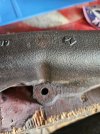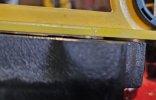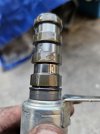Great news it's not the lower end making noise! Upper valve train, while not ideal, is a bit easier. Hopefully it's something that can be remedied without pulling the engine, like pulling a valve cover.
Maybe this? Found this on tappet noise:
Check the oil pressure before disassembling any part of the engine to correct
tappet noise. If vehicle has no oil pressure gauge, install a reliable gauge at the pressure sending-unit. The pressure should be between 107-758 kPa (25-110 psi) at 3,000 RPM
(Refer to 09 - Engine/Lubrication/Diagnosis and Testing) .
Check the oil level after the engine reaches normal operating temperature. Allow five minutes for the oil level to stabilize before checking the oil level. The oil level in the pan should never be above the FULL mark or below the ADD OIL mark on the
dipstick. Either of these two conditions could be responsible for noisy tappets.
OIL LEVEL
HIGH
If the oil level is above the FULL mark, it is possible for the
connecting rods to dip into the oil. With the engine running, this condition could create foam in the
oil pan. Foam in the oil pan would be fed to the
hydraulic tappets by the
oil pump causing them to lose length and allow the valves to seat noisily.
LOW
Low oil level may allow the oil pump to take in air. When air is fed to the tappets, they lose length, which allows valves to seat noisily. Any leaks on the intake side of the oil pump through which air can be drawn creates the same tappet action. Check the lubrication system from the intake strainer to the pump
cover, including the relief valve retainer cap. When tappet noise is due to aeration, it may be intermittent or constant, and usually more than one tappet will be noisy. When the oil level and leaks have been corrected, operate the engine at fast idle. Run the engine for a sufficient amount of time to allow all of the air inside the tappets to bleed out.
TAPPET NOISE DIAGNOSIS
- To determine the source of tappet noise, crank the engine over with the cylinder head covers removed.
- Feel each valve spring or rocker arm to detect the noisy tappet. The noisy tappet will cause the affected spring and/or rocker arm to vibrate or feel rough in operation.
NOTE:
Worn valve guides or ****ed springs are sometimes mistaken for noisy tappets. If such is the case, noise may be dampened by applying side thrust on the valve spring. If noise is not appreciably reduced, it can be assumed the noise is in the tappet. Inspect the rocker arm pushrod sockets and pushrod ends for wear.
- Valve tappet noise ranges from light noise to a heavy click. A light noise is usually caused by excessive leak-down around the unit plunger, or by the plunger partially sticking in the tappet body cylinder. The tappet should be replaced. A heavy click is caused by a tappet check valve not seating, or by foreign particles wedged between the plunger and the tappet body. This will cause the plunger to stick in the down position. This heavy click will be accompanied by excessive clearance between the valve stem and rocker arm as valve closes. In either case, tappet assembly should be removed for inspection and cleaning.
- The valve train generates a noise very much like a light tappet noise during normal operation. Care must be taken to ensure that tappets are making the noise. If more than one tappet seems to be noisy, it's probably not the tappets.
LIFTER PURGE GUIDELINE
- Warm engine to standard idle conditions.
NOTE:
Engine noise may be in the form of a clicking, chatter, or clattering noise.
- Listen to the engine for 30 to 60 seconds with the hood up and the engine cover removed.
- If noise is present, de-aeration of the lifters is required.
- Run the engine between 2000 and 3000 RPM for three to five minutes.
- Return the engine to standard idle speed for 30 to 60 seconds.
- Evaluate noise. If noise is present, repeat the run an additional 4 cycles.
NOTE:
The standard drive cycle will be about 10 - 15 miles of non- stop, combined highway and city driving.
- If noise is present, take the vehicle on a standard drive cycle.
NOTE:
Use a feeler gauge to verify clearance is present between the lifter and cam base circle.
- Evaluate the noise. If noise present, follow standard service procedure for lifter repairs or noise conditions.
- Evaluate lifters for sponginess, check valve defects, and clearance.














